Old cities & towns in Japan
Major historic cities
Kyoto (京都)

Sannen-zaka in Kyoto
Kyoto is a large city and is a popular traditional city.
Needless to say, most foreign tourists visit here while traveling Japan.
So, Kyoto is crowded with the tourists every day.
Kyoto had been the capital of Japan from 794 to 1868.
Traditional houses and many Buddhist temples remain in the city and former court culture is inherited in the city.
Nara (奈良)

Nara Park
Nara is located about 30 km south of Kyoto.
Nara had been the first capital of Japan based on ancient law and Buddhism from 710 to 784.
After that, the capital was moved to Kyoto.
Many old temples are dotted in the city, but the style of the buildings are slightly different from Kyoto.
Wild deer are living in the city of Nara, and they are as the messenger of God.

Higashi-Chaya district in Kanazawa
Kanazawa (金沢)
Kanazawa is a local city located on the Japan Sea side, and is located about 200 km north-northeast of Kyoto.
Kanazawa Castle was built in the late 16th century and the city developed greatly.
The gorgeous industries such as Kimono, craft works with gold leaf, etc. were promoted and the cultures like Kyoto developed.
So, the atmosphere of the city may be similar to Kyoto.
But Kyoto was the city by court nobles and Kanazawa was the city by samurai, so Kanazawa citizen say that Kanazawa is different from Kyoto.
Kamakura (鎌倉)

Great Buddha in Kamakura
Kamakura is the city located about 40 km south of Tokyo.
The capital was in Kyoto, but the first government by samurai had been placed in Kamakura from 1185 to 1333.
The era is called Kamakura Period in Japanese history.
The narrow city area is surrounded by hills.
The palace of the government don't remain, but many Buddhist temples are dotted in the whole area.
The southern area of the city is a popular seaside.
Nikko (日光)

Yomeimon in Nikko Toshogu
Nikko is the religious city where the first Shogun was enshrined in the 17th century.
It is located about 120 km north of Tokyo.
Two Shinto shrines (Nikko Toshogu, Futarasan Shrine) and a Buddhist temple (Rinnoji) are designated as World Heritage Site, and they are in the wide site surrounded by forests.
The gorgeous buildings and carvings are famous.
Old cities and towns in each region
Old cities and towns in Hokkaido Region
Otaru (小樽)
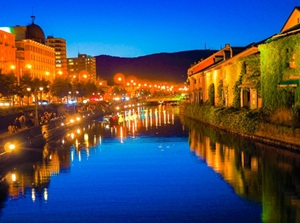
Otaru is located near Sapporo.
Around the end of the 16th century, Japanese people found a good fishing ground of herring around this place.
So, a port was built here, and a coastal route of the Sea of Japan between Otaru and western Japan started.
There are some historical spots around the port.
And, fresh "sushi" in Otaru is famous.
Hakodate (函館)
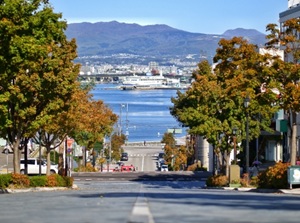
Hakodate has been the entrance city of Hokkaido by ferry from Honshu Island.
In 1859, it became one of the five ports for foreign trade.
So, many Western merchants stayed here, and several Western buildings and churches were built in the city.
Fishery is also a major industry and fresh squid is popular.
The morning market is famous, and there is a major onsen area in the city.
Old cities and towns in Tohoku Region
Hirosaki (弘前, Aomori Pref.)
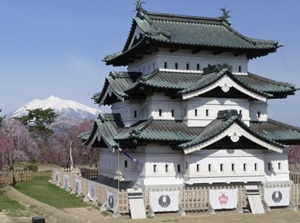
Hirosaki is in the western part of the prefecture.
In the early 17th century, a castle was build here for reigning over the territory of current western Aomori Prefecture.
So Hirosaki had been developed as the central castle town after that.
Cherry blossoms in Hirosaki Castle is famous nationwide.
Old districts and temples are dotted in the town, and some modern buildings are also found.
Kakunodate (角館, Akita Pref.)
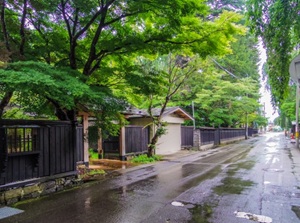
Kakunodate is a small town in Akita Prefecture.
It was a small castle town but the castle was abondoned in 1620.
After that the lord related to the court nobles in Kyoto came to this town and introduced the cultures of Kyoto.
The old samurai residences along a street like Kyoto are popular.
Toono (遠野, Iwate Pref.)
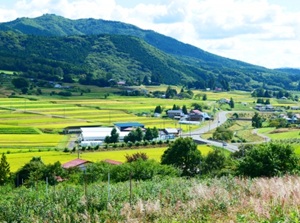
Toono is an inland city with rural landscape and is located to the southeast of Morioka city in Iwate Prefecture.
Many folklores of Toono had been introduced by a Japanese folklore scholar, so Toono city is known as "land of folklore".
The folklores include the nature of old Japan, the customs and character of the land and the unique events.
In the city, various spots about them are dotted.
Sakata (酒田, Yamagata Pref.)

Sakata was a port town in Yamagata Prefecture.
It prospered by a maritime trade hub in the Japan Sea in the 17th to 20th centuries.
Some wealthy merchants appeared in Sakata.
The buildings related to the merchants in those days remain in the city.
Aizu-Wakamatsu (会津若松, Fukushima Pref.)
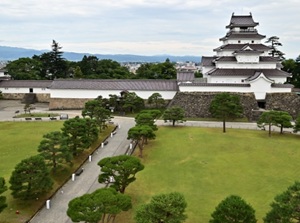
Aizu-Wakamatsu is an inland city of Fukushima Prefecture.
There is Tsurugajo castle and the castle town spreads around the castle.
The castle has the history that young samurais battled to protect the samurai era in 1868.
There are a few beautiful traditional carfts in Aizu-Wakamatsu.
Kitakata (喜多方, Fukushima Pref.)

Kitakata is a small city about 15 km north of Aizu-Wakamatsu city.
In 1880, the city suffered from a massive fire.
After that, many fire-resistant storehouses were built.
So, Kitakata is called as the city of storehouses.
And, "Kitakata Ramen" is one of the three most popular ramen styles in Japan.
There are 120 ramen restaurans in the small city.
Oouchi-juku (大内宿, Fukushima Pref.)

Oouchi-juku was the small town with lodging facilities for travellers and is located about 20 km south of Aizu-Walamatsu city.
It is on the old route connecting Aizu-Wakamatsu and Nikko.
This post station keeps the traditional landscape of the Edo period.
Many traditional thatched houses line along its 450-meter length of the main street.
Old cities and towns in Kanto Region
Kawagoe (川越, Saitama Pref.)
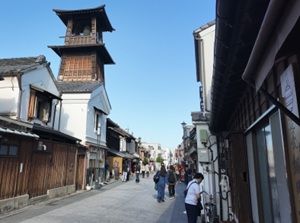
Kawagoe was a castle town and is located about 40 km northwest of Tokyo.
It prospered as a distribution center of various products to Edo.
Especially, a river flowing near the town was used for water transportation to Edo.
And, the town was an important strongpoint of Edo city.
Many old buildings remain in the city, so it is called "Little Edo".
Sawara (佐原, Chiba Pref.)
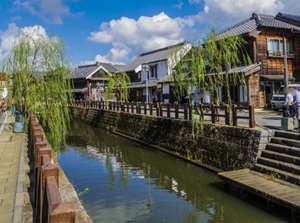
Sawara is a district in Katori city, and is located about 70 km east of Tokyo.
In Edo period, it became a grain-growing district.
The water transportation to Edo also had developed.
Now Sawara is known as a town with old streets and canals.
Mito (水戸, Ibaraki Pref.)

Mito was a castle town and is located about 100 km northeast of Tokyo.
After Tokugawa Ieyasu became Shogun and was founded the Edo government in 1603, one of his sons governed this area.
So, Mito became one of the important domains governed by Shogun family.
There is famous garden "Kairakuen" built by the lord of castle and a school for samurai remains.
Tochigi (栃木, Tochigi Pref.)
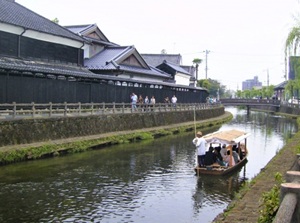
Tochigi city is located about 80 km north of Tokyo.
It was the town on the route between Edo and Nikko.
Uzuma River flows through the city and it leads to Edo.
So this city flourished as an important point for waterway traffic.
There are many old buidings and traditional warehouses built in the 18th and 19th centuries in the city.
Old cities and towns in Koshin-etsu Region
Obuse (小布施, Nagano Pref.)
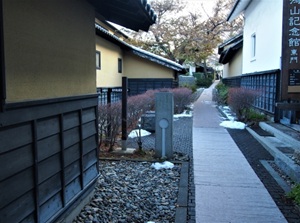
Obuse is a small rural town near Nagano city.
In the 19th century, Katsushika Hokusai who was a famous Ukiyoe (Japanese woodblock prints) artist stayed and created many works in this town.
Sake breweries, chestnut sweets, and Ukiyoe are seen as unique combination of Japanese culture.
Azumino (安曇野, Nagano Pref.)
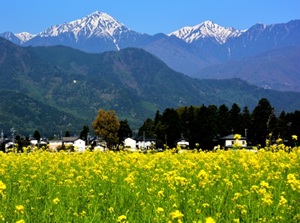
Azumino is a small city just to the north of Matsumoto city with a beautiful castle.
It is at the foot of mountains of Northern Alps a the scenery is beautiful.
Many small clear rivers flow and there are many talismanic stones called as "Dososhin" protecting the village from evil.
Narai-juku (奈良井宿, Nagano Pref.)

Narai-juku was a post station on the old mountain route called "Nakasendo" connecting Edo (Tokyo) and Kyoto.
The town is along a narrow valley formed by Narai River.
Many old buildings are along the road for about a kilometer.
Tsumago-juku (妻籠宿, Nagano Pref.) & Magome-juku (馬籠宿, Gifu Pref.)
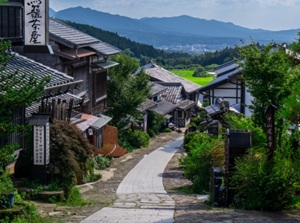
Tsumago-juku and Magome-juku are also the post stations on the old mountain route "Nakasendo".
It is located about 60 km south of Narai-juku.
These post stations are near Kiso River and there are many old buildings in the towns.
There is a mountain pass between them and the walking on the old Nakasendo route for 9 kilometers is popular for the tourists.
Old cities and towns in Hokuriku Region
Takaoka (高岡, Toyama Pref.)
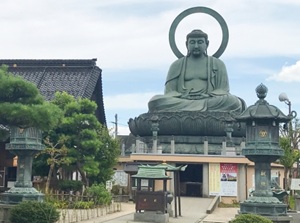
Takaoka is a small city located about 40 km northeast of Kanazawa city.
It was a castle town, but the castle had been demolished in the 17th century.
The old towns remain, and there are a few Buddhist temples designated National Treasures.
There is a great Buddha statue, and it is more handsome than famous Nara and Kamakura statues.
Gokayama (五箇山, Toyama Pref.)

Gokayama is a mountain area and is located about 20 km north of Shirakawa-go village.
Like famous Shirakawa-go, old houses with traditional rafter roof are dotted in the village.
The type of the houses are a little difference from Shirakawa-go, and the reason is that the snow is deeper and heavier in winter.
Obama (小浜, Fukui Pref.)
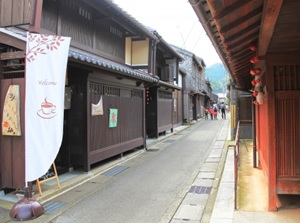
Obama is a city facing the Japan Sea.
It had been the city for sending the marine products of Japan Sea to the capital Kyoto.
Especially, "saba" (mackerel) was the important fish, and the route to Kyoto was called "Saba-kaido" (Mackerel road).
So, the culture of court nobles in Kyoto remains in the old town and there are many Buddhist temples in the city.
Old cities and towns in Tokai Region
Arimatsu (有松, Aichi Pref.)
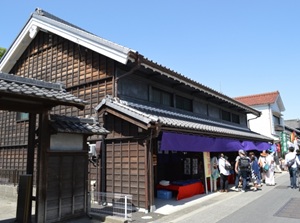
Arimatsu is a district in big Nagoya city.
Arimatsu is on the old main road called "Tokaido" connecting Edo (Tokyo) and Kyoto.
It is located between two post stations and developed as the town of tie-dyeing of cotton cloth as the souvenir for travelers.
The product is called ""Arimatsu Shibori".
Traditonal houses remain along the street, and there are some building relating to "Arimatsu Shibori".
Seki-juku (関宿, Mie Pref.)
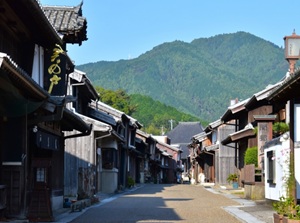
Seki-juku had been a post station on old Tokaido route connecting Edo (Tokyo) and Kyoto.
It is in Mie Prefecture, and is located roughly halfway between Nagoya and Kyoto.
The route to sacred Ise Shrine branched at Seki-juku, so it was an important point of transportation.
Many old buildings remain and are preserved along the street for 1.8 km.
Iga (伊賀, Mie Pref.)

Iga is a city with castle in a basin surrounded by mountains.
It is located about 50 km east of Kyoto.
The soldiers like guerrilla originated in this area in ancient times and they became "Ninja".
Iga Ninja were used as the spy by contract.
In the city, there are the castle and the museum of Ninja.
Takayama (高山, Gifu Pref.)
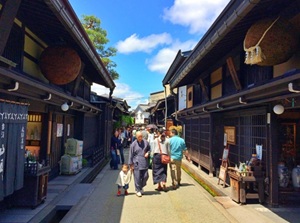
Takayama had been an old in the mountain.
There was a castle, but it was demolished in 1695.
But, the city as the castle town has been preserved and many old buildings remain.
Morning market, Sake breweries, gorgeous festivals in spring and autumn, etc. are the attractive spots for tourists.
Shirakawa-go (白川郷, Gifu Pref.)
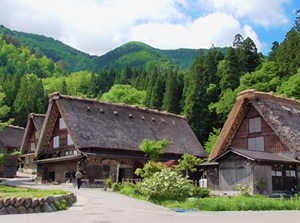
Shirakawa-go is located to the west of Takayama city.
About 100 houses with traditional rafter roof are popular.
The house of this type has been built around this area since the 17th century, and it is called "Gassho-zukuri" in Japanese.
Similar Gokayama area in Toyama Prefcture is close to Shirakawa-go.
Hida-Furukawa (飛騨古川)
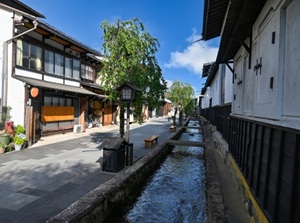
Hida-Furukawa is a small town located to the northwest of Takayama city.
There are some traditional spots in the town.
The atmosphere of the town is similar to Takayama, but there are also unique folkways.
Japanese anime film set in this town was a big hit in Japan in 2016, so Japanese tourists knew this town.
Gujo-Hachiman (郡上八幡)

Gujo-Hachiman is a castle town along a river in the mountain.
The main area is along a valley formed by the river.
It is known as "Water Town".
The river is very clear and the people have been used the water cleverly.
Old town with the canals flowing pure water is attractive, and all-night dance festival in summer is famous.
Old cities and towns in Kansai Region
Oumihachiman (近江八幡, Shiga Pref.)
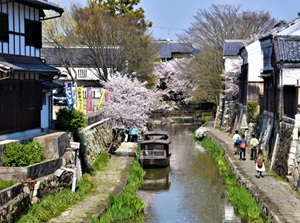
Oumihachiman is a city on the southeastern coast of Lake Biwa and is located about 40 km northeast of Kyoto.
The city was built as a castle town in the end of the 16th century and developed as a commercial city.
The town produced clever and excellent merchants, so they had been called "Oumi-merchant".
There are the moats connecting Lake Biwa in the city, and the old towns are dotted.
Nagahama (長浜, Shiga Pref.)
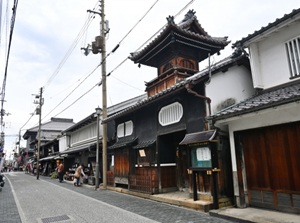
Nagahama is a small city by the north part of Lake Biwa.
It was a castle town and it was the hub of water transport of Lake Biwa.
So, many talented merchants were produced in Edo Period.
There is an old district and we can see the buidings of various periods.
Miyama (美山, Kyoto Pref.)

Miyama is a small village oin the mountains and it is located about 40 km north of Kyoto city.
Japanese traditional houses had thatched roof, but such houses had disappeared in the middle of the 20th century.
In Miyama town, many thatched houses remain and are preserved.
Ine (伊根, Kyoto Pref.)
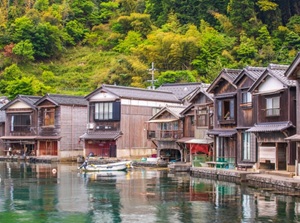
Ine is a small fishing village facing the Sea of Japan and is located about 90 km north-northwest of Kyoto city.
There are unique houses of fisherman called "Funaya" along the seaside.
The garage of ship is located on the first floor, and the dwelling is on the second.
The scenery of the houses is popular.
Old cities and towns in Chugoku Region
Kurashiki (倉敷, Okayama Pref.)

Kurashiki city faces Seto Inland Sea, but the central area is at some distance from the shore.
Kurashiki was a distribution center of various products of the area in the 17th century.
Around Kurashiki River like a canal, old buildings and warehouses are preserved.
The district is designated as a national conservation area of traditional buildings.
Tomonoura (鞆の浦, Hiroshima Pref.)

Tomonoura is a small port town facing Seto Inland Sea and is located to the south of Fukuyama city.
There is an old town around the cove.
The ships sailing on the sea had waited for the change of the flow in this port in the old times.
And, many temples and shrines had been built since the ancient times around this port.
Onomichi (尾道, Hiroshima Pref.)
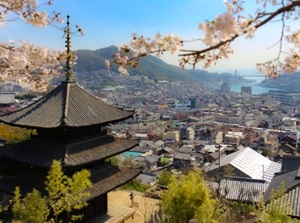
Onomichi is a city facing Seto Inland sea, but there is an island just before the town and the sea is like a canal.
The town is on the slope, and many Buddhist temples are dotted in the town.
The scenery is tasteful, so Onomichi was sometimes used as a scene of novel and a shooting place for a movie.
Takehara (竹原, Hiroshima Pref.)
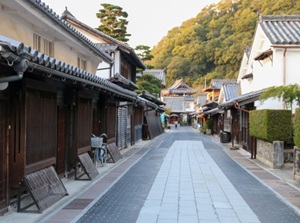
Takehara is a small town in a valley near Seto Inland Sea, and is located about 65 km east of Hiroshima city.
It prospered with salt production and sake brewery in the 17th century.
Rich merchants who made a fortune by such industries lived in this town, so current old town was formed.
The town has the quiet and traditional atmosphere.
Matsue (松江, Shimane Pref.)

Matsue is a lakeside city and the main city in this region.
There is Matsue Castle built in 1611.
It has an original castle tower, so it is designated as national treasure.
There is old samurai town remain by the castle and the pleasure boat is operated in the moats of the castle.
Tsuwano (津和野, Shimane Pref.)

Tsuwano is a small castle town in a valley and is called "Little Kyoto".
In the 13th century, Mongol attacked Japan twice.
A castle was constructed in Tsuwano to prepare for the third Mongol invasion.
After that, the castle town was formed.
And the town has a history of oppression toward Christians by the Meiji government in the 1860s.
So, there are a few spots for Christianity.
Hagi (萩, Yamaguchi Pref.)

Hagi is a small castle town facing the Sea of Japan.
This town produced many spirited samurai to create a new modern nation around the middle of the 19th century.
Therefore, many old buildings remain in the city.
And Hagi ware is well-known as a Japanese traditional pottery.
Yamaguchi (山口, Yamaguchi Pref.)
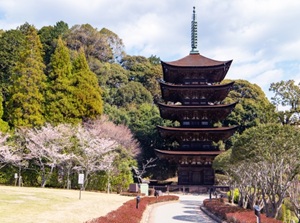
Yamaguchi city is located in a small basin.
It was a central city and the cultures of Kyoto were introduced in the ancient times.
So, the city is called "Western Kyoto".
And, it was introduced by The New York Times as one of "52 Places to go in 2024".
Old temples and shrines are dotted in the town, and there is an onsen resort in the city.
Old cities and towns in Shikoku Region
Wakimachi (脇町, Tokushima Pref.)
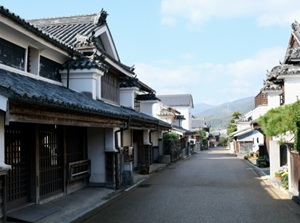
Wakimachi is a small town in Mima city along Yoshino River.
Indigo dye had been the industry of the town.
Many rich merchants of indigo dye lived in this town, and they competed to build gorgeous houses.
Especially, the great firewalls called "Udatsu" on the roof are the symbol of the gorgeous house.
Iya (祖谷, Tokushima Pref.)

Iya is a village in the upstream area of Yoshino River.
It is in the steep and deep valley.
It is said that it was one of the villages where the samurai worriers lost the battle, escaped and hid.
It is one of mysterious lands of Japan, so the experience of the stay in the remote village is popular.
Ozu (大洲, Ehime Pref.)

Ozu is a small city in a valley.
In the 14th century, a castle was built by Hiji River and the castle town was forms around the castle.
The town is also called "Little Kyoto".
The castle tower was restored in 2004, and the tourists can stay in the castle as the lord of the castle.
Uchiko (内子, Ehime Pref.)

Uchiko is a small town near Ozu city.
The town developed by silk, paper and wax production.
Many old houses and the residences of rich merchant and there is a kabuki theater.
The people in this town have preserved the old buildings positively.
Old cities and towns in Kyushu Region
Yanagawa (柳川, Fukuoka Pref.)

Yanagawa is a castle city near Ariake Sea.
The castle was built around the 1500s, but it was demolished in 1872 after the end of samurai period.
Many canals connecting to the rivers were constructed to defense of the castle.
The scenery is attractive, so Yanagawa is often called the city of water.
Hirado (平戸, Nagasaki Pref.)
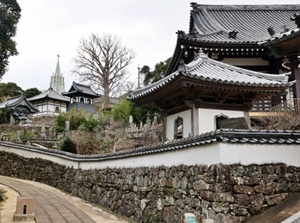
Hirado is a castle city to the north of Nagasaki city.
It was the first place where propagated Christianity was propagated to Japanese people in 1550.
So there are the castle, Buddhist temples, and the Christian Church in the old town.
The mixed scenery is unique.
Hita (日田, Oita Pref.)
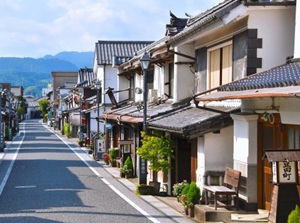
Hita is a castle town in the basin surrounded with many mountains in the center of the northern part of Kyushu island.
Hita area was under direct control of the national government in samurai Period.
So the traditional town was formed like Kyoto, Osaka and Edo (Tokyo).











